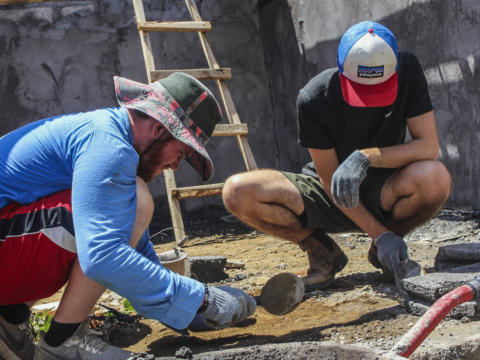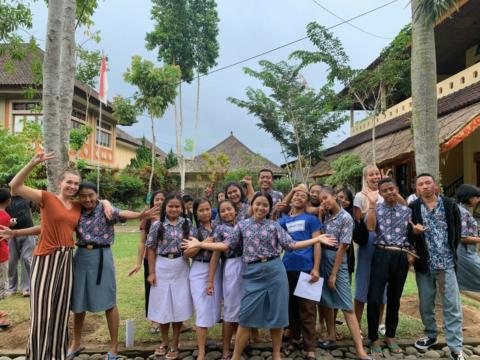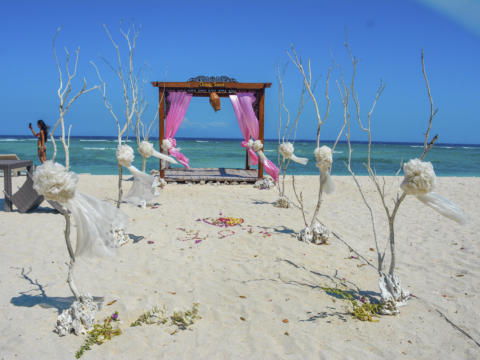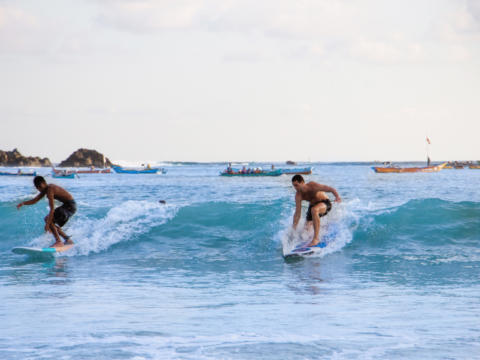Only 420€ per week!
Construction and Renovation
Lombok - Indonesia
This project supports small village communities in and around Lombok. It aims to build and renovate buildings that are essential for the growth and development of the local community.
Throughout the project, you will generally work in schools, centers, playgrounds and public libraries, and support local families by improving living conditions. This would be based on “get your hands dirty” approach where your hard work would create a positive change.
Program Description
The Construction and Renovation project is to support the village community centers such as the village school, village playground, public library etc. Together we will make a difference for the local villages and children, by supporting them to have better living conditions.
The Construction and Renovation project on Lombok supports small communities in and around the island. It aims to build and renovate buildings that are essential for the growth and development of the local community. Our project helps relieve them of some of the stress and pressure that they are living under. Project participants work under a local foreman (coordinator) who provides guidance and training alongside local families. The project involves hard physical and manual labor, as you will be laying bricks, doing carpentry, painting, laying tiles, and landscaping/gardening.
Aims & Objectives
It aims to build and renovate buildings that are essential for the growth and development of the local community.
Schedule
Monday
On Monday, after breakfast, you will start planning the project you take part along with the coordinator. Once the planning is done, you will have lunch and then set out to work at the identified community location. Since it is your first day, you will basically learn about what is required to be done and immediately start working with the support of the coordinator. In the evening, you will come back to the Center and share your feedback at the meeting organized for you.
Tuesday to Friday
From Tuesday to Friday, you will follow the same routine. Now that you have planned what you will be doing at the community locations, you will have some free time till lunch since in the evening you will be working hard to improve the living conditions of the people in need. After lunch, you will start working at the community locations which would be a memorable experience as you will work together with the local community and fellow participants of the project.
Note: This schedule can be changed and/or amended depending on weather conditions, local conditions and unforeseen circumstances.
Participant Criteria & Requirements
Standard Requirements
Minimum age: –
Maximum age: –
Minimum English level: Basic
CRB required: On Signup
Passport copy required: On Signup
Resume copy required: No
Required qualification: None
Additional Requirements
- Participants below 18 are required to provide parental consent letters and participants above 65 should have the medical clearance.
Additional Equipment
Supplies
For all programs, it is imperative to remember that any money raised to help your project when you arrive in Bali will be very well received. Often it is hard for the participants to take too many supplies due to limitations on baggage weight but remember that Bali has some very developed shopping centers where supplies can be bought once you have arrived in the country. This is our recommended and preferred way to contribute to the program. Not only does it mean you do not have to cart the supplies on the plane with you, it means any money you spend will be invested back into the Indonesian (Lombok) economy. Below we have listed some supplies that are very helpful in the teaching and street children programs.
- Hankies
- Balloons
- Bubble Solution
- Face Paint
- Music player and some children's music
- Musical instruments
- Stickers, stamps and certificates
- Group games such as bingo, snakes and ladders, twister etc.
- Colored drawing paper
- Pencils/Pens/Markers/Crayons
- Books (any type)
- Posters
- Colored pavement chalk
- Chalk
Location
Approximately 35 kilometers east of Bali at its closest point, lays the island of Lombok (80 km by 70 km) populated mostly by the Sasak people. Lombok is an Indonesian island east of Bali and west of Sumbawa known for picturesque beaches and prime surfing area. The motor-vehicle-free Gili Islands, off Lombok’s west coast, offer more beaches, reefs for diving and snorkeling, and a sea turtle hatchery. It differs considerably from its neighboring islands, with lots of wide-open spaces and unspoiled beaches, and much less traffic and pollution. The island’s northern area is dominated by the remarkable bulk of Gunung Rinjani, and trekking at least part of the way up is the reason many travelers come to Lombok. Lombok does not receive as much display as its hugely popular neighbor Bali. Nevertheless, many Indonesians prefer vacationing in Lombok over Bali for many reasons: prices for accommodation, food and attractions are often a good deal cheaper, and the island's scenic spots are still unmolested by the gated villa developments, cheap cocktail bars and souvenir shops that have spread across so much of Bali, at least for now.
About the Accommodation
Participants will stay at our Centre in Senggigi. The accommodation is dorm style with bunk beds. There is an refrigerator in the house which can be used by the participants.
Food Arrangements
Indonesian food is tasty and diverse and you can expect to experience a myriad of flavors and meals during your stay. Typical dishes included Mie Goreng (fried noodles and vegetables), Nasi Goreng (fried rice and vegetables) or Gado Gado (mixed vegetables with a satay sauce). For those who do not eat meat, Indonesian cooking uses a lot of tofu and tempeh (soybeans), some western dishes would also be available. Breakfasts are varied and include pancakes, fresh fruit, toast etc.
Facilities
ATMs: There are many ATMs in Senggigi center which is about a 10 minute drive from the house.
– Personal Sim card for your mobile: You can buy at the local shop.
Activities & Events
No scheduled activities outside the program.
Sights & Surroundings
You can visit beaches, go diving, surfing, trekking, visit historical temples and handicraft villages.
Senggigi – Lombok's traditional tourist area Senggigi enjoys a fine location along a series of exotic and extensive bays, with light-sand beaches sitting pretty below a backdrop of jungle-clad mountains and coconut palms. The Senggigi area spans 10 km of coastal road; the upscale neighborhood of Mangsit is 3 km north of central Senggigi. The point at central Senggigi has good waves for surfers. This place has a colorful reef which provides shelter to a variety of marine life and exquisitely shaped corals and makes it a perfect place to snorkel. In the late afternoon a blood-red setting sun sinks into the surf next to the giant triangular cone of Bali's Gunung Agung. Most travelers arrive in Senggigi because many hotels are located over here. It’s also great for going out at night or eating. One of the most popular surf spots for locals and tourists alike is Senggigi Beach. At this beach the vendors and locals aren’t pushy at all but you can have a nice small talk with locals.
Transportation
From this location we do not provide free transport to other locations.
Quick Facts
Name: Republic of Indonesia
Population: 255,461,700 (2015)
Capital: Jakarta
Language: Indonesian (official)
Currency: Indonesian rupiah (IDR)
Time zone: UTC +8
Country Information
Indonesia, a Southeast Asian nation made up of thousands of volcanic islands, is home to hundreds of ethnic groups speaking many different languages. It is known for its beaches, volcanoes and jungles sheltering elephants, tigers and Komodo dragons. On the island of Java lies Indonesia's vibrant, sprawling capital, Jakarta, and the city of Yogyakarta, known for gamelan music and traditional puppetry.
Bali
Dubbed the Island of the Gods, Bali is one of the more than 17,000 islands that make up the Indonesian archipelago. Due to its location off the coast from the mainland and unique culture and religion from the rest of the country, Bali is often treated as a destination of its own, “if you’ve only been to Bali, you’ve never been to Indonesia”.
With its pristine beaches, its unspoilt waters ideal for surfing and diving, its lush mountains, its never-ending rice terrace and volcanic hillsides, its spiritually-infused culture and more, Bali has quickly become a must-visit and it often makes its way on everyone’s bucket list.
Flores
Flores is located in the East Nusa Tenggara province of Indonesia. It has adventure, eco-tours, and mountain climbing interspersed with visits to prehistoric heritage sites, traditional villages and cultural events. It has some of the world’s most exotic marine life. And if you want to see the famous Komodo Dragons alive, this is the only place in the whole world which gives you the experience. You can visit the Komodo dragons in their natural habitats in the Komodo National Park islands. Here you will witness the natural treasures still trying to survive in their purest forms.
Flores is a multi-religious and multi-cultural island where 60% of the people are Christian, 20% Islamic and 20% Hindus and Buddhists. The holidays for Flores are similar to the general Indonesian calendar.
Flores, though one of the main islands in Indonesia, is still trying to keep up with the rest of the country. Evidently, its exceptional natural treasures need more care and its warm hearted people need more support.
Climate
Temperatures are pleasant, varying from 20-33 degrees celsius year-round. The monsoon season strikes in November and makes its way until March, bringing in humidity and a significant amount of rain. However, this usually does not stop people from visiting, as the rain usually begins in the late afternoons and evenings, meaning the daytime remains sun-filled. From June to September, the weather is dry and there is not too much humidity in the air.
Culture
Indonesia is a haven for customs and this can be seen in every corner of the islands. Not to mention the fact that these islands themselves have their own traditions and customs which are different from one another.
A good example of this can be experienced in Bali, where small offerings containing flowers, rice and even cigarettes (sesajen) are found in every house, restaurants, stalls and even at the check-in desks at airports. The offerings are set with burning incense sticks and sprinkled with holy water three times a day before every meal.
There are roughly 20,000 temples spread around the island of Bali and, because the Balinese are masters of sculpture, the temples are guarded with statues of gods and goddesses.
Keep, in mind, however, that the Hinduism you will see in Bali is often different than the one seen in India.
Transportation
By bus
Perama buses are the most famous company that will transport you around Bali and other parts of Indonesia. Another popular company is Trans Sarbagita, which are comfortable and air conditioned and stop on bus stops on road curbs. We highly recommend booking at least one day in advance to make sure there is a seat for you. Moreover, there are shuttle buses (called “Bemos”) between Bali’s most popular destinations.
By Taxi
Taxis are a common way to get around. Blue Bird/Bali Taksi are regarded as one of the most reliable companies. Taxis are metered and the drivers are often able to speak good enough English to understand you. They also have a waiting service, which means they will wait for you while you go sightseeing and take you back home (for an extra charge, of course), if you wish to.





